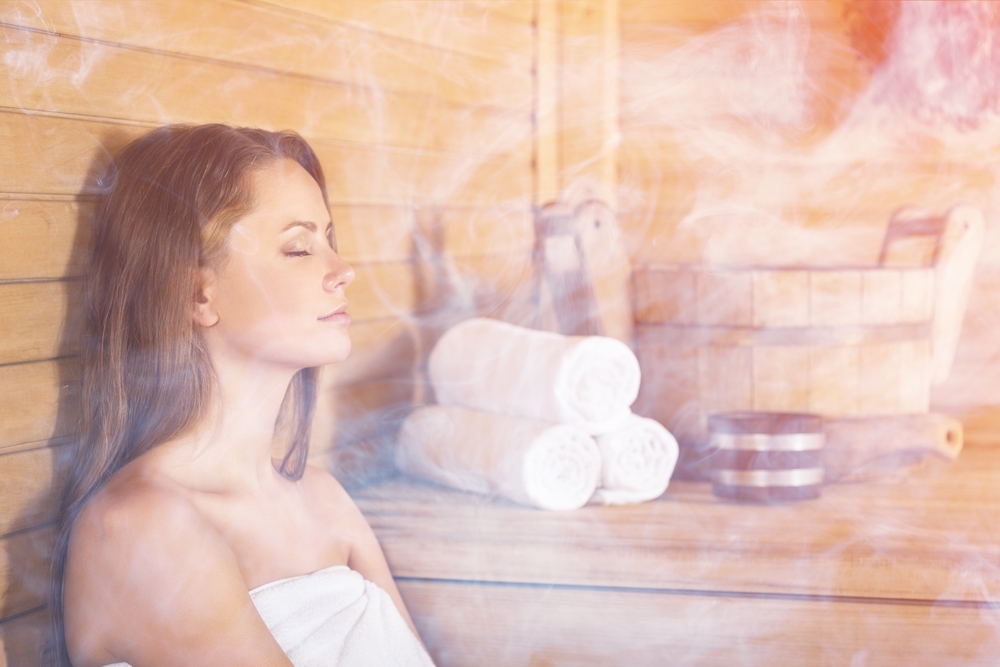Multiple Ways Sauna Use May Improve Athletic Performance
Some of the simplest strategies have tremendous impact on your health. Many of these produce increasing benefit, in much the same way compound interest works. Little changes each day can build to produce significant impact over time. Exposure to extreme temperatures is one that serves as a catalyst to improve your health.
Saunas have historically been a strategy used in Eastern European, Asian and Finnish countries for relaxation, detoxification and more. Athletes are using the extreme heat of saunas for more than post-workout stress reduction and relaxation. Increasing core temperature actually offers conditioning that may improve athletic performance by increasing endurance.1
Exposure to extreme temperatures also has a beneficial effect on mitochondrial functioning, the minute powerhouses in your cells that provide your body with the energy required to function. The key to continued energy production is to remove old and worn-out ones and generate new mitochondria, a process called biogenesis.
Researchers had previously determined that extreme heat can help reduce your risk of cardiac death and hypertension (high blood pressure). They have now identified the direct effect that sauna heat has on vascular health, blood pressure and heart rate.2
Sauna Benefits Vascular Health, Heart Rate and Blood Pressure
Blood pressure is recorded using two different measurements.3 The top number, your systolic measurement, is the pressure inside your blood vessels as your heart beats. The bottom number, your diastolic measurement, is the pressure in your vessels when your heart is at rest between beats. The higher the numbers, the greater the pressure in your arterial system against which the heart must work.
The team publishing the current study also published data from a previous study that was purely observational and suggested sauna use improved health outcomes, including sudden cardiac death, fatal coronary heart disease and all-cause mortality.4 During the current study the team recruited 102 people and monitored the biological effects of sauna use immediately before and after a 30-minute session.5
Cardiovascular and blood-based biomarkers were measured in the participants to evaluate arterial stiffness and blood pressure.6 Data was collected just prior to and after a single session of 30 minutes in a sauna set to 164 Fahrenheit (F) (73 Celsius [C]) with 10 to 20 percent humidity.
The participant’s systolic and diastolic blood pressure measurements both decreased after the sauna session and carotid-femoral pulse velocity7 decreased, indicating beneficial effects on arterial stiffness. The study’s co-author, a cardiologist at the University of Eastern Finland, Dr. Jari Laukkanen, believes that while a sauna session does not give the same muscular benefits as exercise, the cardiovascular responses may be similar.8
Mitochondrial Health Is Foundational to Your Overall Health
The health of your mitochondria is vital to your life and in the prevention of chronic disease. These tiny organelles reside in cells, nearly 2,000 in most cells, although red blood cells and skin cells have little to none. In order for your body to function you require energy, and your mitochondria provide that source of energy. As mitochondrial function is at the heart of disease prevention and in the treatment of chronic illness, it is important to use strategies that support their health and function.
Were all your mitochondria to simultaneously fail you would immediately die. Mitochondria are also responsible for apoptosis, programmed cell death, without which cancer cells freely replicate and grow. Mitochondria also serve as important signaling molecules to help regulate gene expression. As with most cells, your mitochondria are supported by some of the foods you eat and harmed by others. Nutrition is an essential factor in supporting the health and function of your mitochondria.
The vast majority of people who eat mostly processed foods are burning carbohydrates as their primary fuel, which has the devastating effect of shutting down your body’s ability to burn fat and support your mitochondria. This is why obesity is so prevalent, and why so many find it nearly impossible to lose weight and keep it off.
Extreme Heat Benefits Mitochondrial Health
[embedyt] https://www.youtube.com/watch?v=6vJQ_m32UAM[/embedyt]
In this video, biological scientist Rhonda Patrick, Ph.D., discusses how exposure to extreme heat and/or cold help support the creation of new mitochondria, called mitochondrial biogenesis. While there are strategies to support the health of mitochondria, there are four specific strategies to help your body regenerate new ones. These include exercise, exposure to extreme cold or heat, intermittent fasting, and certain supplements like resveratrol.
Patrick believes the most efficient means of regenerating mitochondria is exposure to extreme cold, followed by extreme heat and exercise. This strategy exposes your body to a short burst of stress, activating response pathways encoded in your genes for survival. She explains:
“It turns them on because they’re thinking, ‘I’ve got to prepare for war. This is stress. I need to make sure I fight this off.’ Not only does it activate all these really good pathways to fight off the stress you’re dealing with immediately, but it is preparing for future war. [Your body] is basically thinking to itself, ‘I may encounter this stress again. I have to activate all these good pathways that can help me deal with stress. That way, the next time I encounter it, I’m ready to fight it off.’
That’s really one of the main reasons why short bursts of stress are so good for you, because we have so many amazing genes in our body that are so powerful. The problem is that as we age, they don’t become activated as often. We need to find ways to activate them more …”
Exposure to sauna heat and exercise raises your body’s core temperature, essentially creating a short burst of heat stress. This activates genes that optimize heat shock proteins in your cells. Since these proteins are damaged with time, and accumulation can lead to plaque formation in your brain and vascular system, it is important to prevent this adverse chain of events. Mild heat stress, as experienced in exercise and sauna use, increases the expression of mitochondrial biogenesis regulatory genes.9
Heat Stress Affects Brain Health
Heat has a robust and profound effect on your brain health as your brain benefits from lower blood pressure, greater vascular health and enhanced relaxation.10 Research11 has also demonstrated it increases levels of prolactin, which may promote myelin growth, helping your brain to function faster and repair more efficiently.
Researchers have also discovered a possible link between heat stress and brain-derived neurotrophic factor (BDNF). This factor activates your brain stem cells to convert new neurons and triggers other chemicals to promote neurological health. Researchers have discovered that when you exercise in hot weather it increases the amount of BDNF, as opposed to exercise in cold weather.12 This further supports the use of heat stress to improve your brain health.
Your body also responds to heat by attempting to cool down, increasing production of dynorphin, the opposite of endorphin. Dynorphins sensitize your brain to endorphins, which may explain the mood boosting effect you experience with exercise and heat stress. When you are exposed to heat, reactive oxygen species (ROS) are generated, which in turn increase the production of growth factors such as BDNF. As you age, neurons in your brain may be lost. This strategy may help to slow or prevent the loss of these cells and brain aging.
Multiple Ways Sauna Use May Improve Athletic Performance
While exercising in the heat, your body expends a great deal of energy seeking to control and regulate your internal temperature. Therefore, if you are not acclimatized to training on a hot day, you’ll likely find it more uncomfortable and your performance may be less than stellar. Heat can be a limiting factor in athletic performance. In one study,13 researchers asked an experimental group of competitive male endurance runners to use a sauna for 30 minutes after training four times a week.
They compared performance results against a similar group of athletes who did not use a sauna. After three weeks, the experimental group performed 32 percent better than the control group in an endurance run to exhaustion, and on average decreased their 5K time by 1.9 percent. The athletes also demonstrated an increase in red blood cell production responsible for transporting oxygen to the cells.
Sauna use also stimulates the production of growth hormone, necessary for the reinforcement of bone, muscle growth and longevity, and plays a role in homeostasis. In one study,14 using a sauna for 30 minutes seven times doubled the amount of growth hormone produced and increased the amount of prolactin in participants.
The ventricles in your heart are the main pumping chambers, sending oxygenated blood out to your body. An ejection fraction is the measurement of percentage of blood that leaves the chamber with each pump. Use of a sauna has demonstrated improvements in left ventricular ejection fraction.15 This is particularly useful in times of increased physical stress and athletic performance.
A Variety of Sauna Types Offer Differing Advantages and Disadvantages
Saunas are built to contain heat in a small area, typically elevating air temperature between 158 and 212 degrees F (70 to 100 degrees C).16 Traditional Finnish saunas use dry heat with relatively low humidity, while Turkish saunas use moist heat with relatively high humidity. There are several different types of saunas from which to choose, depending on the heat source:
- Wood burning saunas — Use wood to heat rocks and the room. This produces high temperatures, and you can influence the humidity by pouring water on the rocks, or not.
- Electrically heated sauna — Rooms are high heat and low humidity, generated by an electrical heater attached to the floor of the room. Never pour water onto an electrical sauna heater.
- Infrared, near- and far-infrared saunas — Use special lamps to heat your body from the inside out, and not the entire room. Temperatures in the room are typically lower than other sauna types, but the light heats your body to a similar temperature.
- Steam rooms — Are different in that they provide high moist heat, steam and high humidity.
Infrared, near- and far-infrared saunas are known for their ability to promote detoxification. By heating tissue several inches deep, an infrared sauna may enhance your natural metabolic process and improve blood circulation, helping to oxygenate your tissues. There are several benefits to near-infrared saunas17 over the others, as these offer greater tissue penetration and interaction with chromophores in your body. Chromophores are light-sensitive molecules in your mitochondria and water molecules that absorb light.
The specific light absorbing molecule, called cytochrome c oxidase (CCO), is involved in energy production within the mitochondria. Many don’t realize that light is an important fuel for your cells, like food. When your bare skin is exposed to near-infrared light, CCO increases the production of energy in your mitochondria.
It is also involved in healing and repair, as well as other biological functions. These light waves are absent in artificial light sources, such as fluorescents and LEDs, which is one of the reasons these light sources are so detrimental to your health.
We now know that mitochondrial dysfunction is at the heart of most health problems and chronic diseases, including many signs of aging.18 For these reasons, I strongly recommend using a sauna that offers a full spectrum of infrared radiation, not just far-infrared. Regular exposure to near-infrared through the sun and/or sauna is a powerful strategy to improve your health.
Also beware that most infrared saunas emit dangerous non-native electromagnetic fields (EMFs). So, look for one that emits low or no non-native EMFs. To learn more about this issue, please see my interview with Steve Benda, who has spent many years developing low-EMF saunas.
Essential Tips for Safe Sauna Use
Your skin is a major organ of elimination. However, in many the skin has become inactive. In other words, you just don’t sweat very efficiently. Consistent use of a sauna slowly helps your body restore elimination through sweat, allowing for the removal of toxic chemicals and metals. This daily habit pays serious dividends, including detoxification, improved cardiac health, physical performance, endurance and brain health.
Moderate use of a sauna is safe for most people. However, if you have a heart condition it is wise to consult with your physician first.19 Further precautions include:
• Stay safe — Avoid using a sauna alone as a sudden drop in blood pressure and dehydration may lead to a potentially lethal situation. Avoid the sauna if you are pregnant or if you are ill. Return to the sauna only after you are feeling better, don’t have a fever and are fully hydrated.
Always listen to your body when deciding how much heat stress you can tolerate. If you’ve never used a sauna, you may need to start with just four minutes the first time, adding 30 seconds to each subsequent sauna until you’ve reach 15 to 30 minutes. In some cases, the detoxification process may be severe. This schedule helps your body to slowly acclimate to sweating and eliminating toxins.
• Avoid alcohol — Alcohol increases your risk of arrhythmia, hypotension (extremely low blood pressure), dehydration and sudden death. In a study from Finland, researchers found those who experienced sudden death within 24 hours of using a sauna had a high probability of consuming alcohol at the time.20,21
Avoid the sauna if you’ve had too much to drink in the past 24 hours as well. While you may have heard sauna use will shorten a hangover, it actually increases your risk of dehydration at a time when you are already dehydrated from alcohol use.
• Prevent dehydration and mineral loss — Sauna use increases the amount of fluid you lose through sweating. It’s important to replace that fluid by ensuring you are well hydrated with clean, pure water before using the sauna and paying close attention to rehydrating afterward. Dr. Lawrence Wilson is the author of “Sauna Therapy for Detoxification and Healing,” one of the better resources I’ve read on sauna use.22
Wilson recommends not spending more than 20 minutes in a near-infrared sauna unless you are also on a nutritional balancing program.
This recommendation stems from the profound chemical changes a near-infrared sauna can effect in your body. Although most are beneficial, if you already have unbalanced mineral ratios the process can potentially worsen the problem. Many minerals are lost through sweating. Wilson recommends taking kelp and using a high-quality, unprocessed salt in your cooking. My preference is Himalayan salt in combination with magnesium as most of us are deficient in magnesium.
https://fitness.mercola.com/sites/fitness/archive/2018/06/29/why-are-saunas-good-for-you.aspx
- 1, 13 Journal of Science and Medicine in Sport, 2007; 10(4):259
- 2 Journal of Human Hypertension, 2017;doi:10.1038/s41371-017-0008-z
- 3 Centers for Disease Control and Prevention, Measuring Blood Pressure
- 4, 6 Journal of the American Medical Association, 2015;175(4):542
- 5, 8 Time Magazine, January 10, 2018
- 7 Hypertension, 2005;45:222
- 9 Journal of Applied Physiology, 2012;112(3):354
- 10 The New York Times, December 21, 2016
- 11 European Journal of Applied Physiology and Occupational Physiology, 1988;57(1):98
- 12 Neuroscience Letters, 2011; 494(2):150
- 14 Journal of Human Kinetics, 2003;9:19
- 15 Experimental and Clinical Cardiology, 2007; 12(1):29
- 16, 19, 21 Medical News Today, September 21, 2017
- 17 Dr. Lawrence Wilson, The Benefits of Near-Infrared Energy
- 18 Integrative Medicine, A Clinicians Journal, 2014;13(4):35
- 20 Journal of Forensic Sciences, 2008;53(3):724
- 22 Dr. Lawrence Wilson, Sauna Therapy





Leave A Comment